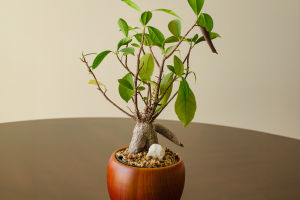Have you ever wondered how traditional flower arrangements can be brought to life with a modern twist?
This summer, a stunning floral arrangement graced the cover of Shangchengshi magazine in Foshan's famous Liang Garden, showcasing not just the beauty of flowers but also the captivating fusion of ancient Chinese aesthetics with contemporary artistry.
The creative genius behind this masterpiece was Chen Shuoyu, a talented floral designer who, despite being only 25, has already left a lasting impact on the world of floral design.
Traditional Meets Innovative in Floral Art
The photoshoot for the magazine required a unique blend of tradition and innovation. The designers wanted flower arrangements that would seamlessly blend into the space, reflecting an ancient, timeless charm while not feeling too old-fashioned. “The flowers had to reflect the space's color scheme, but also maintain a fresh, unique style that deviated from the typical,” Chen Shuoyu explains. True to her style, Chen incorporated modern techniques into traditional Chinese floral designs, giving them a new life.
One particular arrangement that stood out featured a combination of lush, green plants like the mountain return plant and bamboo. The plants were arranged so that they extended outward, almost as if swept by a gentle breeze. The bottom of the arrangement was grounded with dry tree roots, making it compact and sturdy—both an artistic and symbolic choice. “Floral design requires flexibility,” Chen says, noting that the final piece was a dramatic transformation, done in just ten minutes, to meet the photographer's evolving vision for a more understated aesthetic.
Blending Floral Art with Southern Chinese Culture
For this particular photoshoot, Chen also used a traditional flower, the bougainvillea, which is commonly found in Southern China. Paired with colorful window frames that enhanced its vibrant red, the arrangement felt both natural and striking. Her use of locally sourced plants like kangaroo paws and gooseberries only further emphasized the power of nature within this cultural context.
Chen didn't just stop at flowers for her designs. She even drew inspiration from lychee, one of the region's most beloved fruits. With the fruit still in its early stages, she creatively extended the branches, showcasing her resourcefulness in using what nature offered. She even used branches from the dragon jujube tree to provide structure and contrast, bringing a contemporary flair to this traditional concept.
In another standout piece, Chen created a floral hairpiece for actress Song Jia, utilizing the bold and strong palm fronds. “Palms are solid and extend with clean lines, representing the modern woman—beautiful yet resilient,” Chen shares.
Melding Tradition and Innovation
Chen Shuoyu was raised in a family surrounded by art, with both her father and grandfather being renowned photographers. Having been exposed to traditional Chinese culture, Chen initially trained in ballet and classical dance. Over time, she shifted her focus to the world of floral design after studying both Western floral art and Ikebana, which further fueled her passion for mixing traditional themes with modern expressions.
“My aesthetic is deeply rooted in Eastern traditions, but I never want to feel confined by old rules,” Chen says. As she pushes the boundaries of floral design, she tries to create arrangements that speak to both past and present. “Why can't floral arrangements do the same as dance—presenting Eastern beauty through a modern lens?” she muses.
Her work has not only been recognized in the art world but also in high-profile collaborations. For example, in the Louvre·Ou's Showroom exhibition, Chen created a piece titled Four Seasons, which captured the beauty of changing seasons through the use of carefully selected plants. This arrangement was dynamic—green for spring and summer, orange for autumn, and white for winter—symbolizing the continuous passage of time in nature. The display was designed with both artistry and meaning, showcasing how nature and art can perfectly coexist.
Challenges in Balancing Form and Function
In her creative journey, Chen often experiments with unstable visual designs to challenge traditional expectations. She loves playing with the concept of balance in floral arrangements, particularly using materials that appear fragile but are surprisingly stable when put together in a specific way. “It's like a dancer performing with a sense of weightlessness, yet there's incredible strength beneath,” Chen explains.
The process of creating these intricate designs requires both patience and precision. She admits that she enjoys the challenge of working with seemingly unstable materials, which push her to rethink and rethink again. “A well-balanced design may seem easy, but creating instability with actual stability is what excites me.”
Final Thoughts: The Power of Bold Innovation
For those of us in the world of art and design, Chen Shuoyu's work serves as a reminder of the importance of both honoring tradition and embracing innovation. Floral design is not just about arranging flowers; it's about expressing the heart and soul of a culture, and Chen's work proves that even the most classic art forms can flourish with a touch of modernity. Whether you're a budding floral artist or just someone who appreciates the beauty of flowers, Chen's approach challenges us all to look deeper, think differently, and most importantly, continue pushing the boundaries of creative expression.
In the end, it's clear that floral art isn't just about what we see—it's about the emotions it evokes and the cultural stories it tells. So, let's continue celebrating this art form and, who knows? Maybe you'll find yourself inspired to try a little flower arranging of your own!


